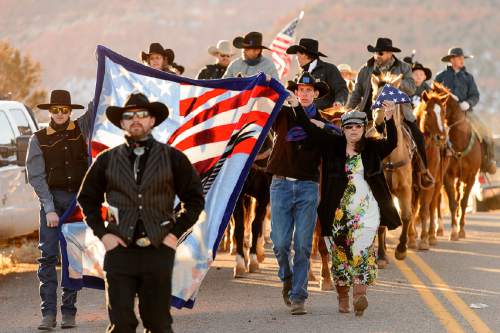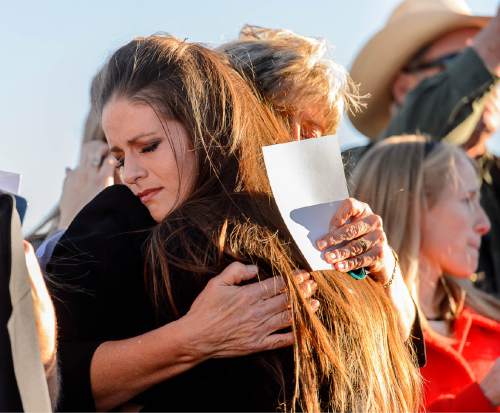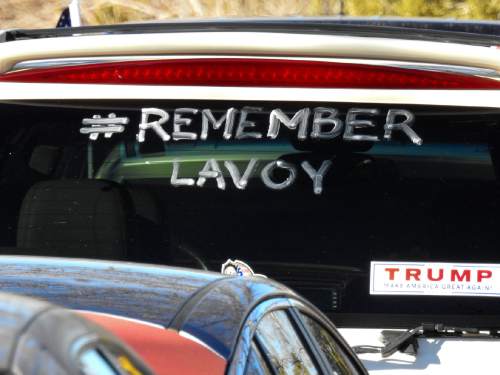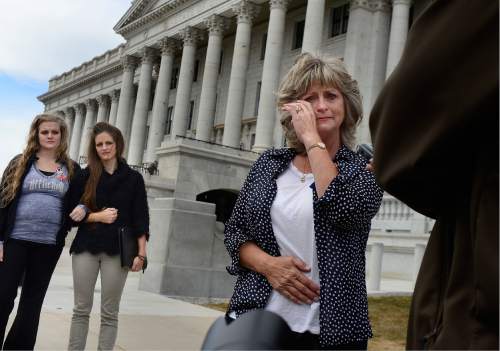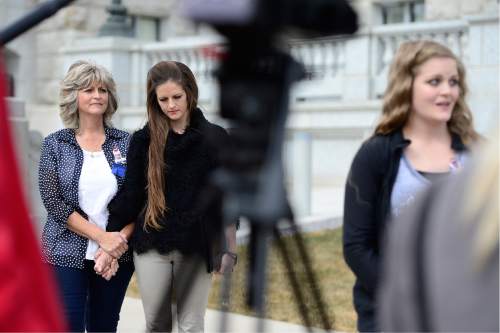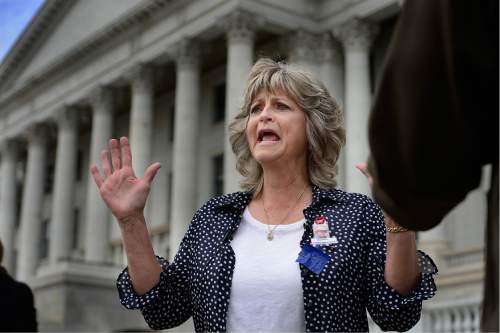This is an archived article that was published on sltrib.com in 2016, and information in the article may be outdated. It is provided only for personal research purposes and may not be reprinted.
State police shot Robert "LaVoy" Finicum three times through the back in what investigators announced Tuesday was a necessary response to Finicum's actions at an Oregon roadblock Jan. 26.
Authorities played video recorded by Kanab resident Shawna Cox, who was in the truck driven by Finicum at the time of the shooting, to explain a law-enforcement narrative that conflicts with the one shared by Finicum's family and supporters.
"OK, boys, this is going to get real," Finicum yells from the driver's-side window at an earlier traffic stop before driving away from law enforcement. "You want my blood on your hands? Get it done, because I've got people to see and places to go."
Finicum was killed in Harney County, Ore., after veering his truck off the road into deep snow — narrowly missing an FBI agent — at a roadblock around a bend on Highway 395. He was driving 70 mph, Deschutes County Sheriff Shane Nelson said Tuesday at a news conference in Bend, Ore., that updated a weekslong probe into the officer-involved killing of the 54-year-old Arizona Strip rancher.
Finicum's widow, Jeanette, announced to hundreds of supporters at the Utah Capitol on Saturday that her husband was "murdered, assassinated by our government." On Tuesday, she read a response from the steps of the Washington County Building in St. George.
"We have talked with an independent investigator who has stated that the 'video proves a set-up assassination,' " Finicum said. "Many people, including my lawyers, have tried to prepare me for this — 'Be strong,' 'Accept this with peace' — but I don't think anything could prepare me to accept what is so clearly a finding that challenges the Constitution that my husband died defending."
The probe is not over, due to two shots fired by unknown agents from the FBI's Hostage Rescue Team that were not initially disclosed to investigators.
Nelson said the three shots that contributed to Finicum's death were among six fired by state police, all of which were ruled justified, including three fired at the truck as it careened off the road.
But FBI agents also fired two shots as Finicum exited the truck. Nelson said the agents' nondisclosure was "of particular concern" and has prompted an extension of the investigation that involves the Office of the Inspector General for the Department of Justice.
An FBI Hostage Rescue Team was involved in the 1992 northern Idaho siege at Ruby Ridge, where the son and wife of extremist Randy Weaver were shot to death.
U.S. Attorney Billy J. Williams and Special Agent in Charge of the FBI in Oregon Greg Bretzing told the Bend media audience they couldn't comment further while the investigation is ongoing.
Video shows Finicum at the first stop, after Ryan Payne exited the truck and was detained, explaining to law enforcement that he is heading toward a meeting with Grant County Sheriff Glenn Palmer.
He turns to ask the truck's other occupants whether they want to get out. None says yes.
Cox advises Ryan Bundy, seated behind Finicum, to call Joseph Rice, an Oregon-based militia activist who founded the Pacific Patriot Network and played a supporting role in the Malheur National Wildlife Refuge occupation.
Bundy tries to place the call, but he does not have cell service.
Cox asks: "If we duck and you drive, what are they going to do? Try to knock us out? How much farther do we have to go?"
"We've got about 50 miles," Finicum says before turning up the volume on his radio, playing A Great Big World's "Hold Each Other."
Finicum later yells out the window: "Hey boys, you'd better realize, we've got people on the way. You want a bloodbath, it's going to be on your hands."
He sped away about a minute later. Moments before they crashed into the snow, he can be heard shouting, "Hang on! Hang on!" amid apparent gunshots.
After leaving the truck, Finicum can be heard on Cox's video repeatedly yelling, "Go ahead and shoot me!"
Previously released overhead footage from an FBI plane showed Finicum exiting the truck and running through the snow, his hands held up until he appeared multiple times to reach his right hand toward his left side, where, the FBI would later say, he carried a loaded 9 mm semiautomatic handgun.
Jeanette Finicum has said she believes those movements were a reaction to being shot, though authorities said he had yet to be hit.
Nelson said Finicum was told to get on the ground twice. While an officer armed with a stun gun closed in to use nonlethal force, Finicum was ordered to the ground a third time and two state police officers at Finicum's back observed that he again reached toward where the gun — a gift from a relative, investigators said — was later found.
The two state policemen then fired three shots, which all struck Finicum.
The FBI has said it deployed flash bangs and sponge projectiles with an agent similar to pepper spray to disorient the truck's occupants after Finicum was shot. Two loaded .223-caliber semiautomatic rifles and a loaded .38 special revolver were later found in the truck, the FBI previously announced.
Authorities' accounts differ from those of Cox and fellow passenger Victoria Sharp. The truck's occupants said law enforcement fired hundreds of rounds at the vehicle.
Cox, who has filed a lawsuit over her treatment by federal and state law enforcement, said she was surprised that authorities used her video to illustrate the shooting and expressed suspicion that it was "cut down as much as they possibly could."
"There's no justification at all," said Cox, who promised to provide more evidence in court. "It's totally not true."
Jeanette Finicum has said she believes the truck's occupants were unarmed because Palmer had instructed the occupation leaders to come to the John Day meeting without guns.
She said Tuesday that she plans to "seek justice in a different court, under different circumstances," and that she would comment further Wednesday "after we review their findings fully."
Stewart Rhodes, founder and president of the Oath Keepers patriot group, faulted law enforcement for using a roadblock, which Rhodes said automatically creates a use-of-force situation by forcing a suspect to drive at prone officers, who are then exposed as the suspect exits a vehicle.
Rhodes also said investigators are "not turning over all the incriminating chatter on their side."
"Police across the country have a credibility problem ... precisely because investigations are handled this way. They're not forthcoming, and they drag their feet releasing all the evidence."
Finicum's family commissioned a private autopsy but has yet to release the results. Supporters at Saturday's rally said Finicum was shot nine times, including once through the head and additional shots while he was down.
Rhodes said the Oath Keepers hope to help the Finicums conduct an independent investigation.
About 700 people filled a Mormon meetinghouse in Kanab for Finicum's service in early February.
Hundreds more stopped by the church — patrolled by armed men who said Finicum's family had received death threats — to pay their respects. Some had never met Finicum, yet had traveled from out of state.
Cliven Bundy — whose standoff with federal authorities at his Bunkerville, Nev., ranch led Finicum to disavow his own grazing permit with the Bureau of Land Management — took part in a memorial ride after the service. He was arrested for conspiracy and assault days later.
Finicum is said to have arrived in Oregon with no change of clothes, planning only to attend a rally in support of Harney County ranchers Dwight and Steven Hammond, who were ordered to return to prison to fulfill a mandatory minimum sentence for a series of fires on BLM lands, before returning to his ranch on the Arizona Strip.
But he joined the armed occupation at the Malheur National Wildlife Refuge and became its de facto mouthpiece, receiving national media attention for spending a night outside on watch duty beneath a blue tarp. And while he came across in interviews as a well-spoken man with a soft manner, he said he would rather die than spend his days in a "concrete box."
Cox was among more than two dozen refuge occupants indicted during the 41-day standoff.
Twitter: @matthew_piper
Tribune reporter Brian Maffly contributed to this story




